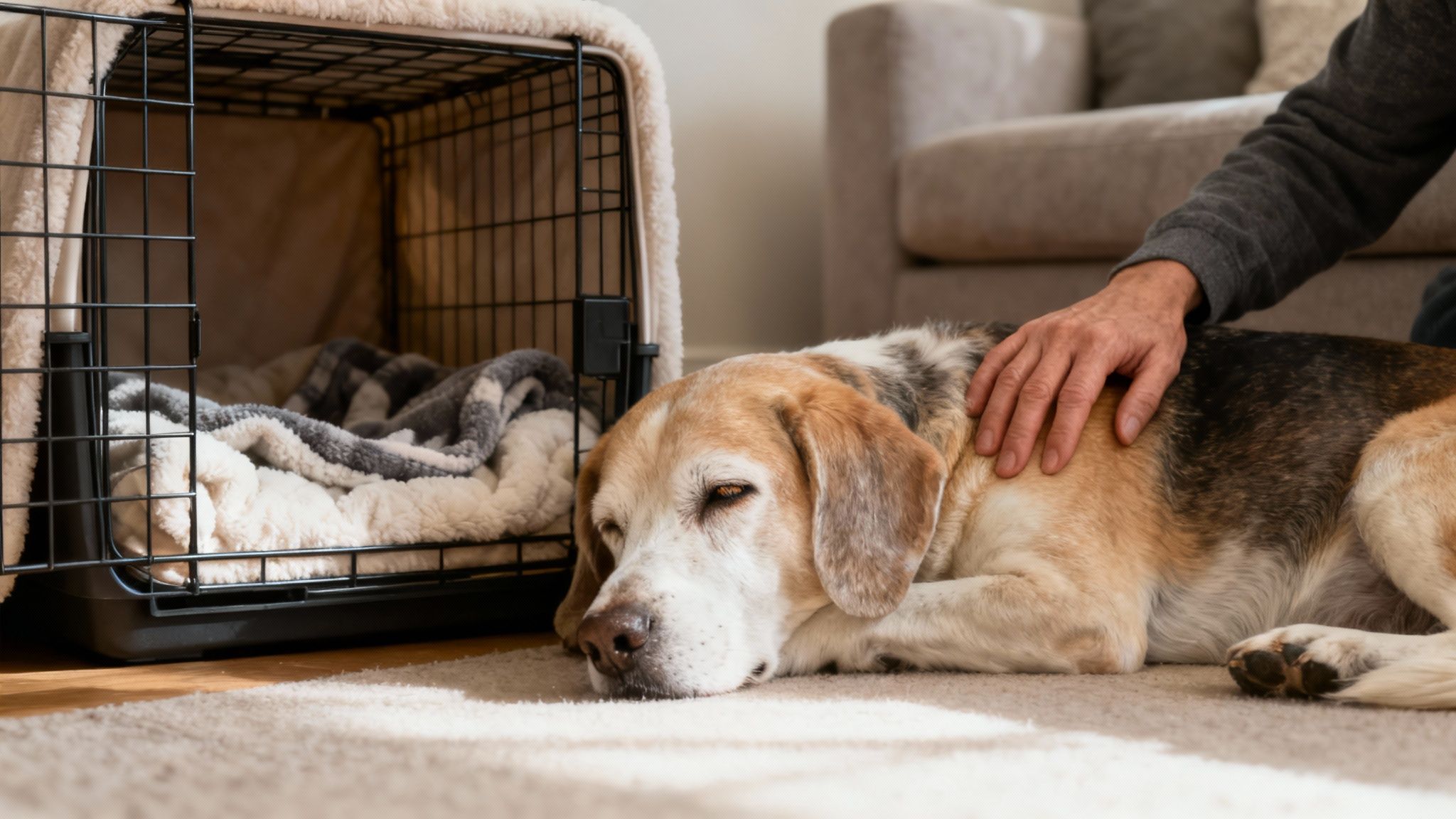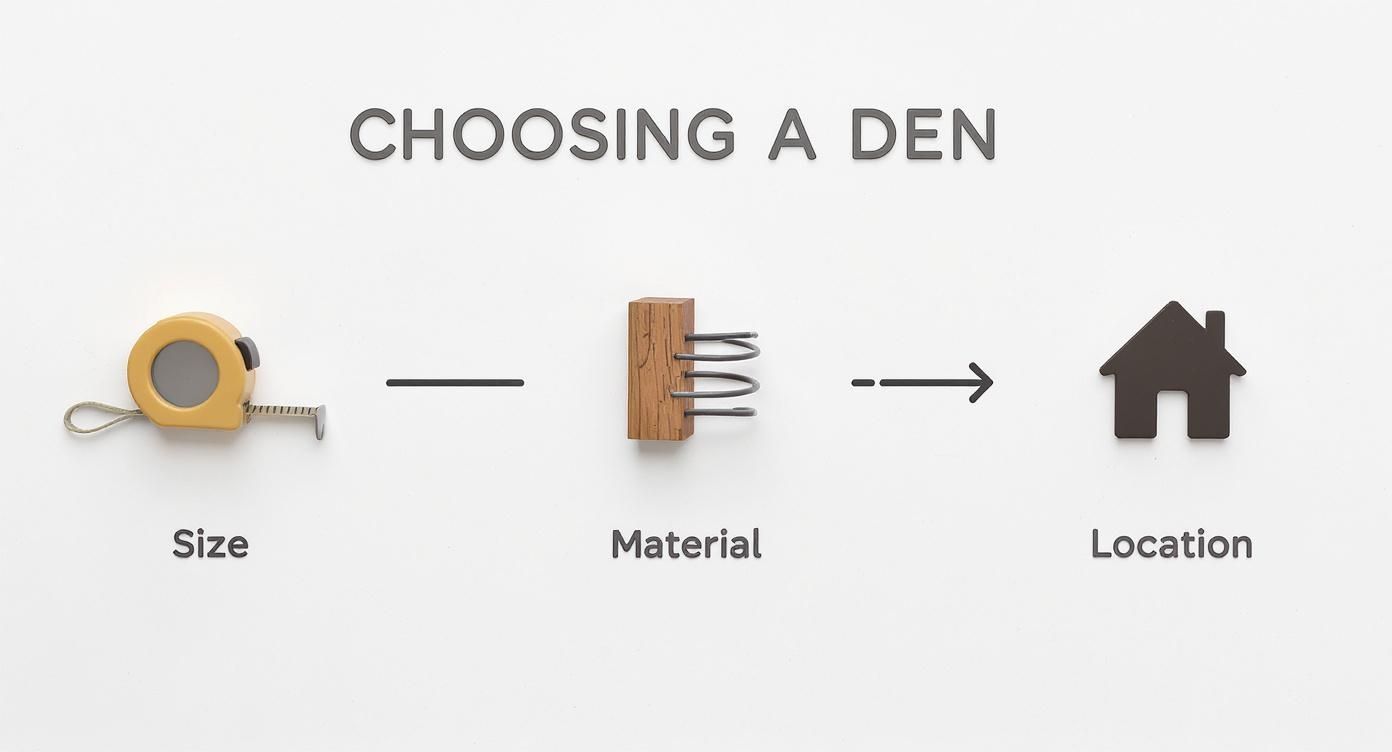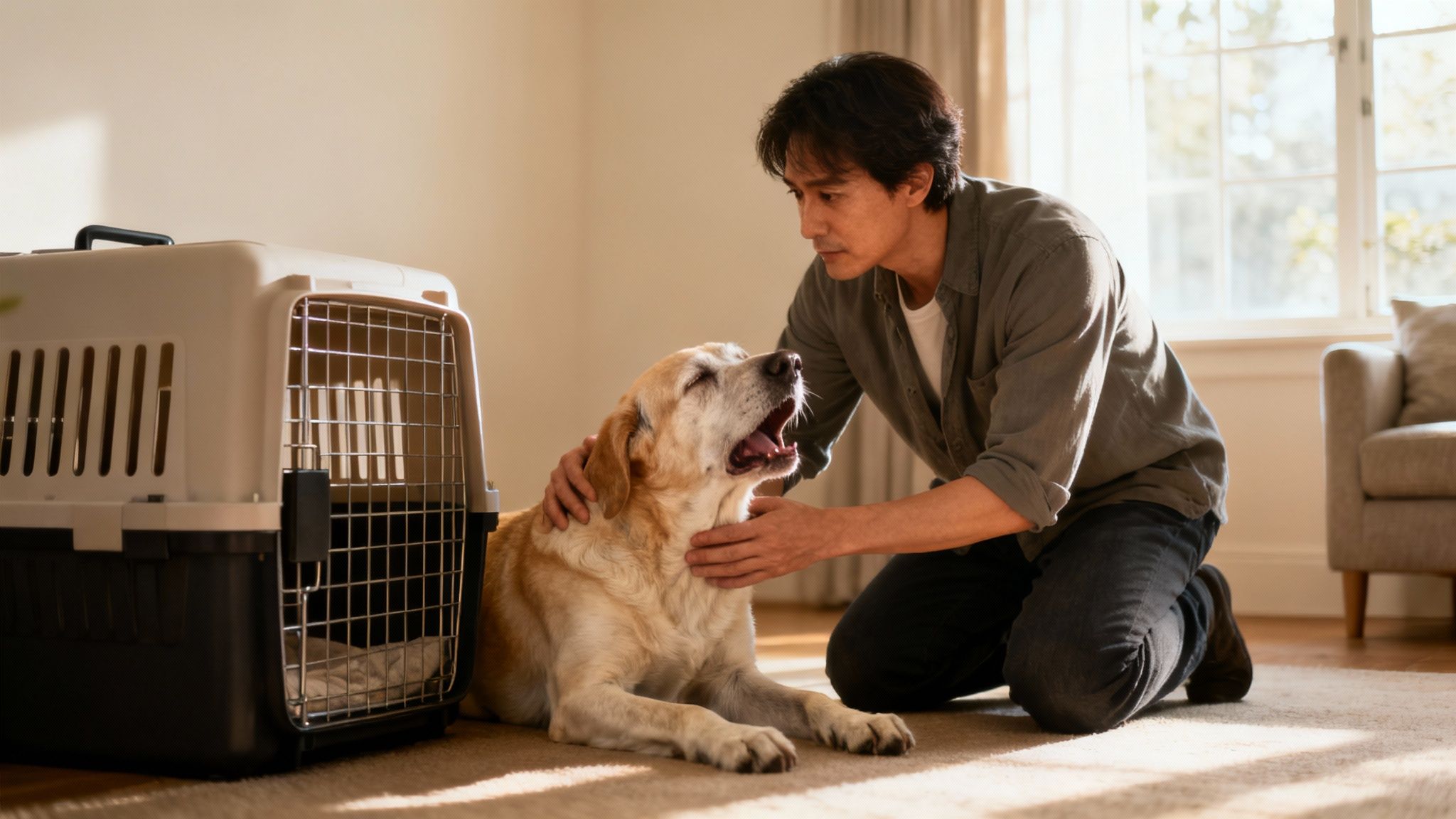A Compassionate Guide: Can You Crate Train an Older Dog?

Table of Contents
Key Takeaways
Trust Over Tricks: Crate training an older dog is possible and deeply rewarding. The focus isn't on obedience, but on patiently building a bond of trust and safety.
The Den Instinct: Reframe the crate as a safe, cozy den that taps into your dog’s natural, wild instinct for a secure space of their own.
Listen Deeply: Success hinges on understanding your dog’s past and reading their body language. Their history and comfort level dictate the pace of training.
Patience is a Virtue: The journey happens at the speed of trust, not on a human timeline. Setbacks are communication, not failures, offering a chance to connect more deeply.
Of course you can crate train an older dog. Let’s start by getting one old myth out of the way: the idea that senior dogs are stuck in their ways. The truth is, their ability to learn is lifelong. This process is less about teaching ‘tricks’ and more about building a deep, unwavering trust that honors their wild wisdom.
Why An Old Dog Can Still Learn New Tricks
This guide is built on a foundation of patience and a deep understanding of your dog’s innate denning instincts. We're going to reframe the crate not as a cage, but as a cozy den—a safe space that honors their wild ancestry.
Crate training is a powerful opportunity to deepen your bond. It helps your dog feel secure while giving you a chance to practice empathy and connect with your own intuitive nature. Every small step becomes a quiet conversation, a chance to really listen to what your dog is telling you without words. This journey of rewilding can be gratifying to both of you.
And the experts agree. A 2022 survey found that 78% of veterinarians recommend crate training for dogs of all ages.
To truly grasp an older dog's capacity for learning, it helps to understand the importance of mental stimulation for canine cognitive health. When we engage their minds, we tap into their brilliant, adaptable nature.
Ultimately, crate training is a form of behavior modification that strengthens their mental health. You can find more wisdom on this in our guide to understanding dog behavior modification techniques. It’s about creating a shared language built on safety and mutual respect.
Understanding Your Dog's Unique History
Before considering crate training, it's essential to pause and connect with your dog's individual history. This isn't about training techniques just yet; it involves attentive listening. Successfully crate training an older dog starts with understanding their past experiences and the way they communicate through body language.
If you're unsure about your dog's history, begin by simply observing them. Notice how they move around your home and where they prefer to rest. Dogs that gravitate towards cozy, enclosed spaces—like under a table or in a quiet corner—indicate a natural preference for security. This suggests they may easily accept a crate as their personal refuge.
This observation process encourages you to slow down and engage with your dog. By interpreting their non-verbal signals, you strengthen your bond with them and demonstrate that they are acknowledged and understood. Building this trust is crucial for any training process you undertake.
Reading Their Story
Each dog signals their readiness in their own distinctive manner. Your task is to understand their behavior and use it to plan for their future. Watch for these subtle indications.
Positive Signs Your Dog Is Ready:
They Seek Enclosed Spaces: If they often nap under a desk, in an open closet, or behind the sofa, it indicates an active denning instinct.
They Have a Calm Demeanor: Dogs that are generally relaxed and confident in their surroundings are usually more receptive to new experiences like crate training.
They Are Food Motivated: A fondness for treats can facilitate creating a positive association with the crate, making the experience enjoyable for them.
Red Flags to Honor
On the flip side, some dogs carry stories that require a much slower, more sensitive approach. These aren't signs of failure—they are invitations for deeper empathy. Honoring these signals is absolutely crucial.
If your dog shows intense fear—trembling, hiding, or completely shutting down at the mere sight of a crate—it’s a clear signal to pause. This is often seen in rescues who may have traumatic associations with confinement from their past. Fear is a primal instinct that deserves our respect.
Severe separation anxiety is another major red flag. A crate can actually worsen this if it’s not introduced with extreme care and, often, with professional guidance.
Honoring your dog’s history—whether you know it or not—is the most profound way to connect with their wild wisdom. It transforms training from a simple task into a ritual of mutual respect and understanding.
Creating a Safe and Inviting Den
The whole secret to crate training is getting your dog to see the crate not as a box, but as their own private sanctuary. Think about it: for a dog, especially an older one with a set routine, the world can feel a little chaotic. Tapping into their natural denning instinct gives them a deep, primal sense of security.
It grounds their energy and gives them a space that is 100% their own. This isn't just about setting up a crate; it’s a beautiful ritual where you intentionally craft a haven that honors their wild soul.
The first step in this ritual is picking the right crate. The goal here is cozy, not cavernous. Your dog needs just enough room to stand up, turn around, and lie down comfortably—but not so much space that it feels like an open field. A den is meant to be a snug retreat that makes them feel protected from all sides.
Getting this right sets the entire tone for your training journey together.
Selecting the Right Style
The material of the den can completely change how your dog feels about it. Each type offers a different vibe, speaking to different canine instincts.
Wire Crates: These are fantastic for visibility. They let your dog feel connected to the pack (that's you!) even while they're resting. They also offer excellent airflow and let your dog keep a watchful eye on what's happening, which can be really comforting for some personalities.
Plastic Crates: Often called "flight kennels," these offer a more enclosed, cave-like environment. If you have a dog who loves to burrow under blankets or snooze under the coffee table, a plastic crate can feel incredibly secure and private.
Ultimately, the best choice is the one your dog feels most at ease in. If you're looking for a little more guidance, our complete breakdown on choosing the best dog crate can help you find the perfect fit for your companion's needs.
Where to Place the Den
Once you have the crate, where you put it is just as important as what it's made of. Placement is about connection, not isolation.
Find a spot in a communal area—like a quiet corner of the living room—to help your dog feel like part of the family's daily rhythm. They can retreat to their safe space while still hearing and sensing your presence nearby. This reinforces their role in the pack and helps keep feelings of loneliness at bay.
Part of creating a truly safe den also means keeping the space clean without harsh chemicals. Using the best pet safe cleaning products ensures their sanctuary remains a healthy, non-toxic space.
Making It Irresistible
The final touch is furnishing their new den with things that spell comfort and familiarity.
A soft bed or an old blanket that carries your scent can make the space instantly more inviting. Toss in a favorite safe chew toy to give them a positive activity to associate with their den time. Think of it like decorating their personal room—a place designed purely for deep rest and quiet contentment. This small act of care is what transforms a simple crate into a cherished retreat.
A Gentle Journey to Crate Confidence
This is where the real heart-work begins. Think of this part of the journey as a quiet, patient dance of trust between you and your dog. It’s all about positive reinforcement and showing deep respect for their natural instincts. We'll move through gentle, manageable phases—from the first curious sniff to longer, relaxed stays in their new den.
The golden rule here is simple: the crate must always feel like a magical place, never a punishment. This whole process is a conversation, and the only clock that matters is your dog's comfort level. Trust your gut and move at their pace.
The First Introduction: A Ritual of Curiosity
Let’s start by making the crate the most interesting thing in the room. With the door propped open or taken off completely, just sit near it and bring a calm, positive energy to the space.
Toss some high-value treats—think tiny pieces of chicken or freeze-dried liver—near the crate, then just inside the doorway. Don't push or coax. Let their wild curiosity lead them. Celebrate every tiny step forward—a sniff, a glance, a single paw inside—with soft, encouraging praise. This isn't about getting them in the crate; it's about helping them decide on their own that this is a place where good things happen.

As you can see, creating an inviting den is a deliberate ritual, not just a purchase. It's about aligning the space with your dog's instinctual needs for safety and comfort.
Building Positive Associations
Once your dog is willingly stepping inside to grab those treats, it's time to build on that positive foundation. You can begin feeding their meals inside the crate, always with the door open. This connects the den to another primary, positive instinct: nourishment.
Next, introduce a special, long-lasting chew toy that they only get inside the crate. A frozen KONG or a favorite bully stick works wonders. This creates a powerful link between their den and a feeling of deep, satisfying contentment. The goal is to teach them that the crate is a place for peaceful, rewarding activities.
The Dance of the Door
When your dog is happily eating or chewing away in their den, you can gently swing the door closed for just a second, then open it again right away. Do this while you're sitting right there, projecting a calm vibe. No big fanfare needed.
Gradually, you can extend the time the door is closed, starting with just a few seconds and slowly building up. If your dog stays relaxed, you’re on the right track. If they show any signs of stress—whining, pawing, panting—you’ve moved a bit too fast. No worries. Just go back to the previous step where they were comfortable. This is your chance to practice deep listening, and for them to build unbreakable trust in you.
If you're noticing signs of stress, read more on how to help your dog calm down.
The benefits of this patient approach are huge. A 2021 study found that 73% of adult and senior dogs in shelters who received crate training were adopted within three months. Even better, they were 40% less likely to show destructive behaviors after adoption. This data really shows how creating a sense of security can profoundly impact an older dog's wellbeing and their future with a family.
Navigating Setbacks with Patience and Empathy

Let’s be real: training is never a straight line. It’s more of a spiral, with beautiful moments of progress and days that feel like a giant leap backward. This is the natural rhythm of learning, for both of you.
When challenges pop up—whining, barking, or just flat-out refusing to go in the crate—the invitation isn't to correct more forcefully, but to listen more deeply. These behaviors aren't your dog being stubborn. They are pure communication, a little window into their inner world. A soft whine might be their way of saying, “I’m not quite comfortable yet,” or maybe, “Hey, I really need to go outside!”
Shifting your perspective on this is everything. It transforms you from a trainer into a trusted translator for your dog’s needs. Setbacks are not failures. They are invitations to slow down, listen with more presence, and reconnect with the wild, intuitive wisdom that flows between you and your dog.
Tuning Into Their Communication
When you hit one of those bumps in the road, take a deep breath and become a gentle detective. Instead of zeroing in on the behavior itself, get curious about the feeling behind it. This empathetic approach honors their innate wisdom and strengthens the trust you're building together.
Ask yourself these soulful questions:
Is their body comfortable? Is the den too warm or too cold? Is the bedding just right?
Is their energy balanced? Have they had enough movement and sensory exploration today to feel settled? A good sniff walk can work wonders.
Are they feeling lonely? Remember, dogs are pack animals. Sometimes, all they need is for you to move the crate a little closer.
These simple check-ins often resolve the issue because they address the root cause, not just the symptom. You're responding to their emotional needs, and that's the heart of this entire journey.
Don't lose heart if the process feels slow. Patience and positivity really do pay off. One study found that an incredible 88% of senior dogs successfully learned to accept their crates when their humans used positive methods. Better yet, 75% of them showed less anxiety within the first month. You can read more about these findings here.
Enrichment as a Calming Ritual
In times of challenge, altering the energy can be beneficial. This is where enrichment serves as a calming ritual, beneficial for both you and your dog, and can be introduced after crate training.
Scent work is highly effective for this purpose. It engages your dog’s natural instincts, helping them concentrate, alleviate stress, and connect with their inherent skills. By fostering this instinctual exploration, the crate can become a more secure environment.
Wondering if scent work is done in the crate? Yes, it can be incorporated into crate time to enhance your dog's sense of safety. Ready to engage your dog's natural instincts? Download our free guide to a more connected life, one sniff at a time.
👉 Get your FREE Nosework Guide here!
FAQ: Common Questions About Crate Training Older Dogs
How long does it take to crate train an older dog?
There’s no one timeline. Every adult dog carries their own history, personality, and emotional pace. While many dogs begin to feel comfortable within 4–6 weeks, others may take a few months — especially if they’ve experienced past trauma or instability.
Focus on your dog, not the clock. Keep training sessions short and gentle, offer plenty of soft encouragement, and use high-value dog treats to reinforce bravery and calm moments. Progress unfolds at the speed of trust — and trust is what you’re truly building here.
What if my older dog has separation anxiety?
If your dog struggles with separation anxiety, introducing the crate slowly is essential. A crate should feel like a comforting dog bed inside a safe den — not a space of isolation.
Start building positive associations while you’re home. Let your adult dog relax near or in the crate with the door open, and make it a place where good things happen. If the anxiety is significant, partnering with a professional trainer or veterinary behaviorist can provide support tailored to your dog’s needs.
Can I leave my older dog in the crate all day?
Crates are for rest and resetting the nervous system, not long-term confinement. As a guideline, an adult dog shouldn’t be crated more than 4–6 hours at a time. Senior dogs or dogs still working on house training may need more frequent breaks.
If you work long hours, consider alternatives like:
A dog-proofed room with a cozy dog bed
Puzzle toys or safe enrichment activities
A midday walk from a trusted dog walker
The goal is support, not restriction.
My rescue dog is terrified of the crate. What should I do?
If there is true fear, we slow way down. Forcing a scared dog into a crate breaks trust quickly.
Set the crate up in a shared living space with the door removed or secured open. Then, simply let it exist in the environment. Occasionally toss high-value treats near the entrance, and later just inside, without asking your dog to enter.
This approach gives your dog the space to rewrite the meaning of the crate — on their terms — with choice, safety, and agency at the center.
